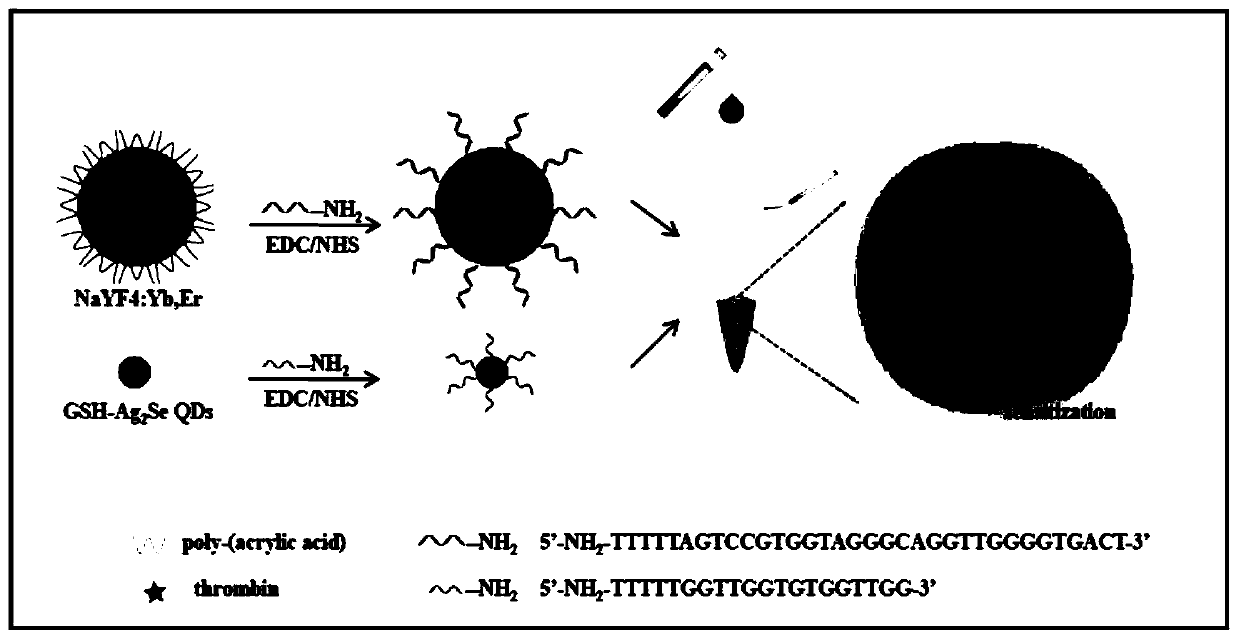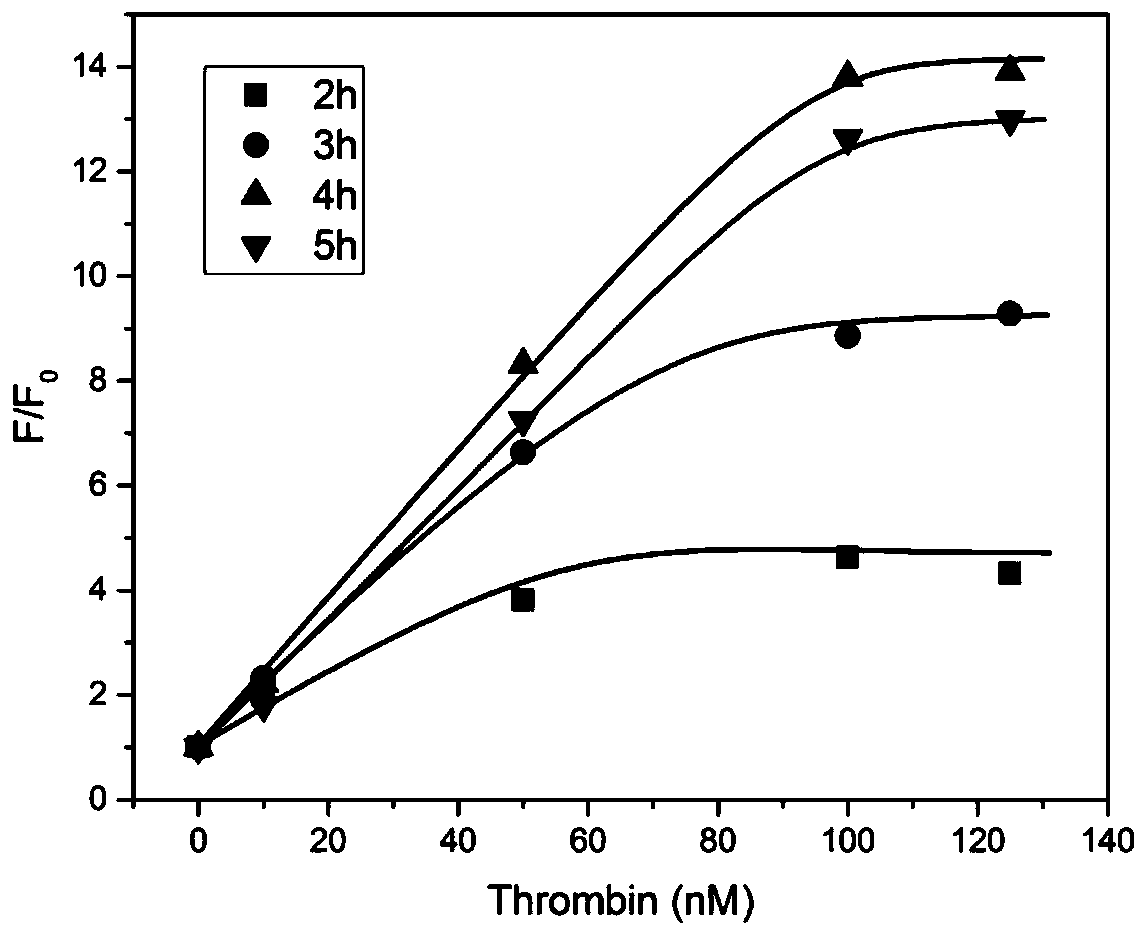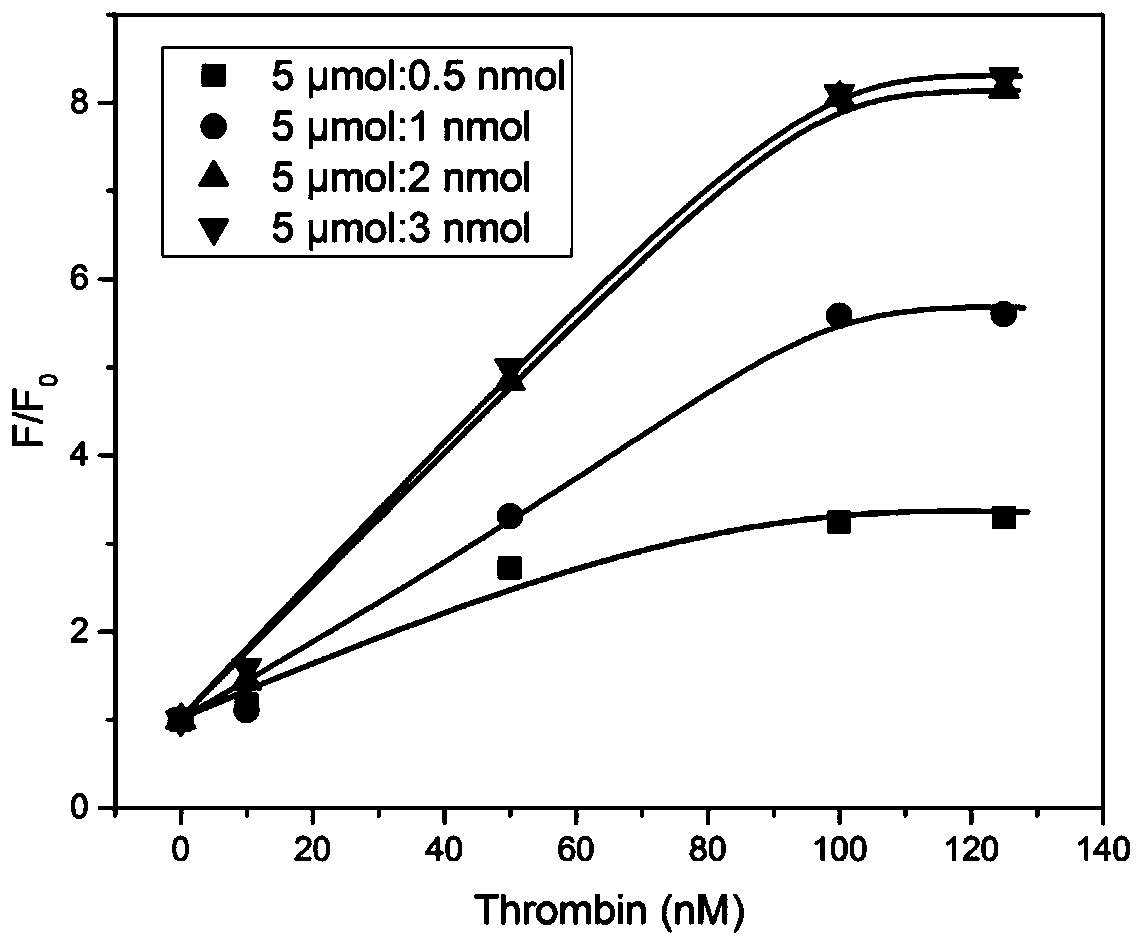Method for detecting thrombin by utilizing quantum dot sensitization upconversion nano material
A technology of quantum dot sensitization and thrombin, which is applied in the direction of material excitation analysis, fluorescence/phosphorescence, etc., can solve the problem of low signal-to-background ratio, achieve high-sensitivity detection, large absorption coefficient, and improve the effect of detection signal-to-background ratio
- Summary
- Abstract
- Description
- Claims
- Application Information
AI Technical Summary
Problems solved by technology
Method used
Image
Examples
Embodiment 1
[0039] A method for detecting thrombin using quantum dot sensitized upconversion nanomaterials, comprising the following steps:
[0040] (1) Prepare TBA1-UCNPs solution as described above;
[0041] (2) TBA2 and Ag 2 Coupling of Se QDs: 5 μmol Ag 2 Se QDs were added to 1 mL PBS buffer (10 mM, pH=6.8), and after sonication for 5 min, 10 mg EDC·HCl and 5 mg Sulfo-NHS were added thereto, and shaken at room temperature for 30 min. Activated quantum dots were collected by centrifugation, washed twice with PBS buffer (10 mM, pH=7.2) and dispersed in 1 mL of PBS buffer (10 mM, pH=7.2) containing 2 nmol TBA2. Then, incubate at room temperature for 4 h with shaking to obtain the coupling product. Finally, the coupling product was washed three times with PBS buffer (10 mM, pH=7.2), and dispersed in 1 mL Tris buffer (10 mM, pH=7.4), recorded as TBA2-QDs, and stored at 4°C for future use.
[0042] (3) Draw a thrombin detection standard curve: add 0.01mg of TBA1-UCNPs obtained in step (...
Embodiment 2
[0048] A method for detecting thrombin using quantum dot sensitized upconversion nanomaterials, comprising the following steps:
[0049] (1) Prepare TBA1-UCNPs solution as described above;
[0050] (2) TBA2 and Ag 2 Coupling of Se QDs: 5 μmol Ag 2 Se QDs were added to 1 mL PBS buffer (10 mM, pH=6.8), and after sonication for 5 min, 10 mg EDC·HCl and 5 mg Sulfo-NHS were added thereto, and shaken at room temperature for 30 min. The activated quantum dots were collected by centrifugation, washed twice with PBS buffer (10mM, pH=7.2) and then dispersed in 1mL PBS buffer containing 0.5-3nmol TBA2 (0.5, 1, 2, 3, respectively). (10 mM, pH=7.2). Then, incubate at room temperature for 4 h with shaking. Finally, the obtained coupled products were washed three times with PBS buffer (10 mM, pH=7.2), and dispersed in 1 mL Tris buffer (10 mM, pH=7.4), respectively denoted as TBA2-QDs-0.5, TBA2-QDs-1, TBA2-QDs-2, TBA2-QDs-3, stored at 4°C for future use.
[0051] (3) Draw a thrombin dete...
Embodiment 3
[0057] A method for detecting thrombin using quantum dot sensitized upconversion nanomaterials, comprising the following steps:
[0058] (1) Prepare TBA1-UCNPs solution as described above;
[0059] (2) TBA2 and Ag 2 Coupling of Se QDs: 5 μmol Ag 2 Se QDs were added to 1 mL PBS buffer (10 mM, pH=6.8), and after sonication for 5 min, 10 mg EDC·HCl and 5 mg Sulfo-NHS were added thereto, and shaken at room temperature for 30 min. Activated quantum dots were collected by centrifugation, washed twice with PBS buffer (10 mM, pH=7.2) and dispersed in 1 mL of PBS buffer (10 mM, pH=7.2) containing 2 nmol TBA2. Then, incubate at room temperature for 4 h with shaking, and finally, wash the coupled product three times with PBS buffer (10 mM, pH=7.2), disperse in 1 mL Tris buffer (10 mM, pH=7.4), and store at 4°C for future use .
[0060] (3) Draw a thrombin detection standard curve: add 0.01mg of TBA1-UCNPs obtained in step (1) and 0.016nmol of TBA2-QDs obtained in step (2) to 0.2mL HE...
PUM
| Property | Measurement | Unit |
|---|---|---|
| Particle size | aaaaa | aaaaa |
| Particle size | aaaaa | aaaaa |
Abstract
Description
Claims
Application Information
 Login to View More
Login to View More - R&D
- Intellectual Property
- Life Sciences
- Materials
- Tech Scout
- Unparalleled Data Quality
- Higher Quality Content
- 60% Fewer Hallucinations
Browse by: Latest US Patents, China's latest patents, Technical Efficacy Thesaurus, Application Domain, Technology Topic, Popular Technical Reports.
© 2025 PatSnap. All rights reserved.Legal|Privacy policy|Modern Slavery Act Transparency Statement|Sitemap|About US| Contact US: help@patsnap.com



